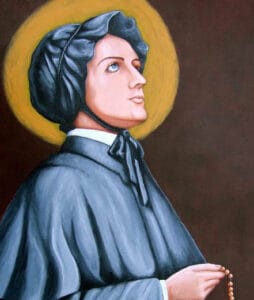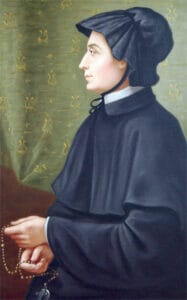
In this week’s episode of Saint of the Week, we celebrate Saint Elizabeth Ann Seton, a woman whose journey from wealth to widowhood, from heartbreak to holiness, changed the face of education and religious life in America. Her deep faith, resilience, and compassion continue to inspire millions across the world.
Elizabeth Ann Bayley was born on August 28, 1774, in New York City, into a prominent Episcopalian family. Her father, Dr. Richard Bayley, was a respected physician, and her mother, Catherine Charlton, came from a devout Anglican background. Tragically, Elizabeth lost her mother at the age of three, an early sorrow that shaped her tender and reflective nature.
Despite this loss, Elizabeth grew into a bright, charitable young woman. She loved Scripture, music, and poetry and was known for her desire to help the poor and sick, even as a teenager.

At age 19, Elizabeth married William Magee Seton, a wealthy shipping merchant. The couple shared five children and a deep mutual affection. Elizabeth was known for her devotion as a wife and mother and for her service to the needy in New York’s growing population.
However, tragedy struck when William’s business collapsed due to economic hardship. His health deteriorated soon after, and in 1803, the family traveled to Italy hoping the warmer climate would restore him. Sadly, William died of tuberculosis shortly after arriving in Livorno, leaving Elizabeth a widow at 29, with five young children.
Conversion to Catholicism
While in Italy, Elizabeth was deeply moved by the Catholic faith of her hosts, the Filicchi family. Their devotion to the Eucharist and Our Lady stirred something profound in her heart. When she returned to the United States, she began exploring the Catholic faith despite facing opposition from friends and family.
In 1805, Elizabeth was received into the Catholic Church, making her the first native-born American woman to publicly convert. Her decision cost her social standing and financial support but she clung to her faith, writing in her journal: “God is my Father, and in His care I will rest.”
Founding the First Catholic School

To support her family, Elizabeth began teaching in Baltimore. Her compassion and leadership caught the attention of Bishop John Carroll, America’s first Catholic bishop, who invited her to start a school for girls.
In 1809, she founded St. Joseph’s Academy and Free School in Emmitsburg, Maryland, dedicated to educating poor children. This institution marked the beginning of the parochial school system in the United States.
Later that same year, she established the Sisters of Charity of St. Joseph’s, the first religious community for women in the U.S., based on the rule of Saint Vincent de Paul. The Sisters took vows of poverty, chastity, and obedience, and devoted themselves to education, healthcare, and social service a mission that continues to this day.

Elizabeth’s health declined in her later years, but her faith never wavered. She continued to guide her sisters and students with love and spiritual wisdom, reminding them to “meet our grace in the moment.”
She died peacefully on January 4, 1821, at the age of 46, surrounded by her Sisters.
Her cause for canonization began in 1882, and after the Church confirmed three miracles attributed to her intercession, she was canonized by Pope Paul VI on September 14, 1975, becoming the first American-born saint.
Her feast day is celebrated on January 4 the anniversary of her death.

Saint Elizabeth Ann Seton’s impact endures in countless schools, hospitals, and charitable works founded by her spiritual descendants. The Sisters of Charity continue her mission in education and service across the world.
She remains a powerful role model for mothers, teachers, widows, and converts a reminder that God can bring holiness out of hardship.
What We Can Learn
Saint Elizabeth Ann Seton’s life teaches us that faith can transform suffering into mission. She turned grief into purpose, using her pain as a foundation for love, education, and service. Her legacy calls us to serve with compassion, trust God’s plan, and find holiness in everyday life.
“The gate of heaven is very low; only the humble can enter it.” — Saint Elizabeth Ann Seton






